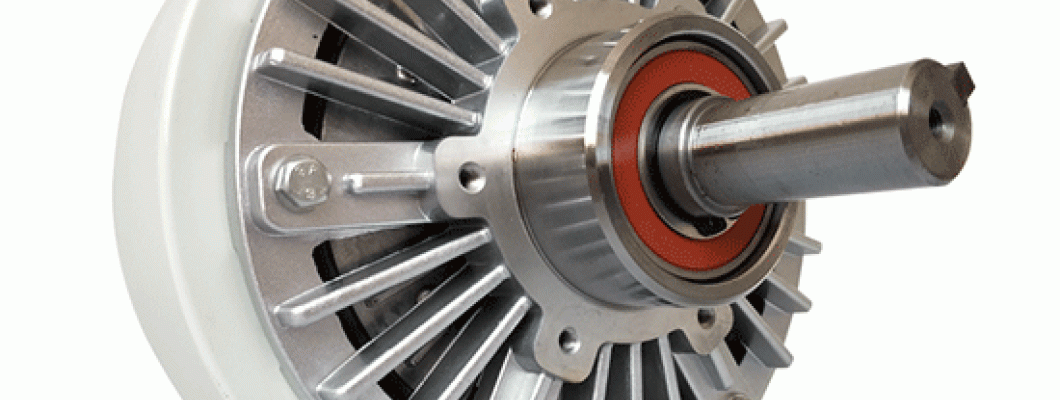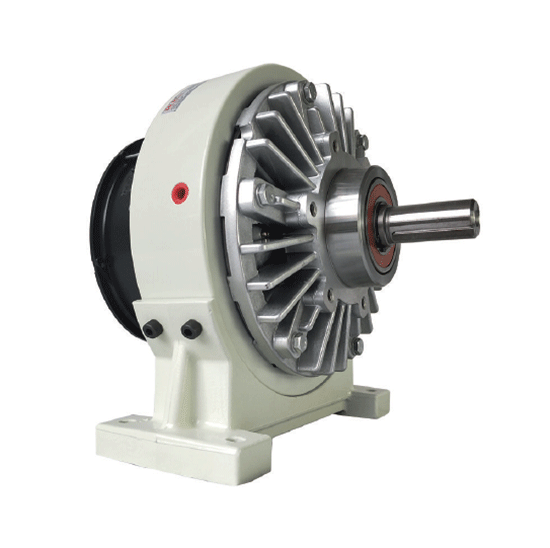
The magnetic particle brake is composed of a transmission unit (input shaft) and a driven unit (output shaft). The space between the two sets of cells is filled with granular magnetic powder (about 40 microns in volume). Magnetic powder brake is based on electromagnetic principle and adopts magnetic powder to transmit torque. The output torque has a good linear relationship with the excitation powder current, but has nothing to do with the speed or slip. The magnetic particle brake features fast response, simple structure, no pollution, no noise, no shock and vibration, and energy saving. It is an automatic control element with multi-purpose and superior performance, has been widely used for unwinding and winding tension control in papermaking, printing, plastics, rubber, textiles, printing and dyeing, wire and cable, metallurgy, tablet presses and other processing industries. Magnetic powder brakes are also often used for dynamometric loading and braking of transmission machinery.
Magnetic Particle Brake Working Principle
1. The magnetic powder brake is a new kind of transmission element, which uses magnetic powder as the medium and forms a magnetic powder chain to transmit torque under the condition of electrification. The brake is mainly composed of inner rotor, outer rotor, excitation coil and magnetic powder.
2. When the coil is not energized, the active rotor rotates. Due to the centrifugal force, the magnetic powder is thrown on the inner wall of the active rotor, there is no contact between the magnetic powder and the driven rotor and the active rotor runs idly.
3. After the DC power supply is turned on, an electromagnetic field is generated, and the magnetic powder forms a magnetic powder chain under the action of the magnetic force line, which connects the inner rotor and the outer rotor so as to transmit and brake torque.
Magnetic Particle Brake Function
1. Buffer start and stop.
2. Continuous sliding and tension control
3. Torque limit
4. High-speed response
5. Power absorption
6. Positioning stop
7. Simulating load
Magnetic Particle Brake Features
1. Continuous sliding operation can be achieved.
2. A stable torque can be obtained.
3. No beeping sound. Slip on the action surface occurs in the friction method, but it does not occur here, and there is no connection sound, so the operation is quite quiet.
3. The heat capacity is very large. Since the magnetic powder with excellent heat resistance and an ideal cooling method are adopted, it can run well even during severe continuous sliding operation.
4. A smooth continuous and driving state can be achieved. Since the coefficient of both static friction and dynamic friction is almost the same, there is no vibration when they fully get connected and the acceleration and deceleration can be adapted according to the load.
How to Select Magnetic Particle Brake ?
The selection of magnetic powder brakes is generally based on the maximum torque required to be transmitted and at the same time, the actual slip power is less than the allowable slip power of the magnetic powder clutch and brake. the Calculation formula is as follows.
Actual slip power P=2×3.14×M×n/60=F·V (unit: W)
In the formula:
M - Actual working torque (N.m)
F - Tension (N)
n - slip speed (r/min)
V - Linear velocity (m/s)
In the case of no speed change mechanism, the product of the maximum tension required by the winding material and the maximum winding radius should be less than the rated torque of the magnetic powder brake. In addition, the selection of the magnetic powder clutch is also related to its position. On the premise of matching the slip power, if the magnetic powder clutch is placed in the high-speed stage, a smaller size clutch can be selected, and its volume and cost will be reduced accordingly. When the small size magnetic powder clutch cannot be matched and a larger magnetic powder clutch is required, it should be placed in the middle or rear of the transmission mechanism to increase the working torque and reduce the slip speed.
With the heat dissipation conditions for both magnetic powder clutches and magnetic powder brakes constant, their slip power is a certain value, so their actual working torque and speed can compensate each other, namely, when the slip speed increases, the allowable torque will decrease accordingly, but the maximum peed must not be higher than its allowable speed.
For example, PEACO-PBO magnetic powder brake has rated torque M=100N.m, slip power P=7 kW, then rated speed n=9550*P/M=9550*7/100 = 668.5r/min. If actual slip speed n=1500r/min (9550 is a constant coefficient), the allowable torque should be M = 9550*P/n=9550*7/1500=44.6N.m (9550 is a constant coefficient).


Leave a Comment